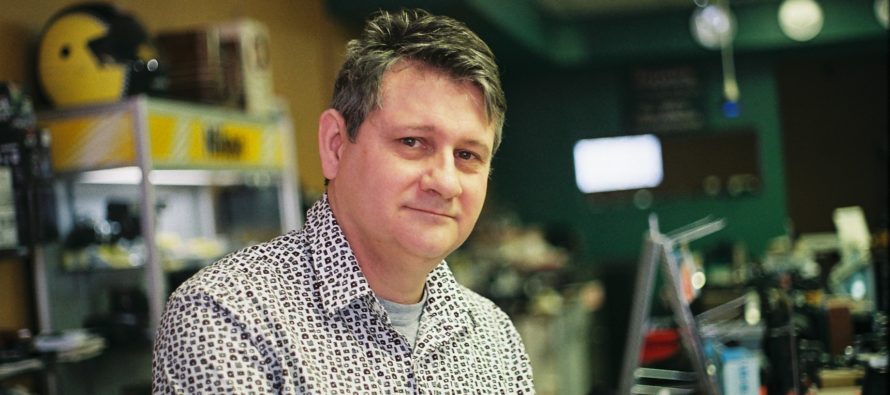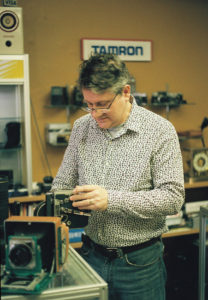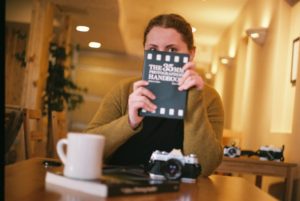Film is not dead.

“The report of my death is an exaggeration,” – Mark Twain
Over the past decades, technology has been improving at a rapid pace and scale. Each year, a new smartphone gets released with a more powerful battery and camera, and now, with 4K video capabilities and increasing megapixel sizes.
With technology rapidly improving each year, old ways of doing things, such as using VHS, Blu ray – DVD and cassette tapes are starting to become a thing of the past. Not to mention watching TV and even listening to the radio.
In the early 2000s, people were also ready to also put film in their rearview mirror – as digital was just beginning to take over. But, there was also a large group of photographers who were sticking to their film, because the evolution of digital still had some developing to do at the time.
“It was certainly interesting to watch the transition, because you know we could see it coming from a ways off,” said Adrian Harte, who has owned Windsor Photo Outfitters for the last 10 years.
“When it did hit, it hit hard and fast. Sales just dropped like a stone and cameras that were only five, seven years old became almost worthless.”
Harte didn’t originally intend to be a camera store owner. The England native was a journalist for many years, even helping to establish the Amherstburg paper River Town Times. But eventually he decided he wanted to work on cameras full time and left that job to work with John Lachance at “TurnAround Camera” in 1994.

Adrian Harte holding an old video camera from the 1900s, in his shop Photo Outfitters on Feb. 22 2019. (Photo by Kaitlynn Kenney)
Eventually, the name was changed to Windsor Photo Outfitters to reflect the different offerings in the store. Later on, Lachance retired and sold Harte the store. And he said now he usually works alone from his shop, keeping busy with his many customers who come in for repairs. He said he sees a variety of customers, lots of them around his age who are hobbyists, as well as older people who stick to their film cameras. And recently, younger people who start investing into film equipment.
Harte remembers the digital shift well because people were excited about being able to email photos to friends and family, and get instant feedback from the camera, which is customers had always demanded from photographers. By 2003 – 2004 the quality of digital cameras got good enough for professionals to switch over, and that’s when a large audience gradually stopped using film.
Harte said during that time, people would ask a lot of questions about what to do next. Whether to invest in digital cameras, much of which were selling for around $2 grand for two to three megapixels, or to stay with their film equipment. And his advice for a long time was to wait until the technology advanced.
“I have tried really hard to do more digital lately. For a long time, I only picked up a digital camera when I really needed it, but film was the thing I took most seriously,” Harte said.
“That changed a lot when e6 film became almost impossible to get, and be processed. And I got some digital cameras finally that I liked.”
Brad Maclaren, owner of Maclaren’s Photo Lab in Windsor Ontario agrees that lots of people got excited about early digital cameras.
“The age ranges for my customers are 20 to 30, 50 to 70 and nothing in between”, said Maclaren. “(the shift) was terrifying. For at least five years, we had no idea what was going to happen.”
Maclaren’s has been open since 1976, and has been at its current location since 1980.
When they first opened, other big chains in Windsor told him he wouldn’t last more than a few years, and now he is the only mini lab still open in the city and beyond.
“The closest mini lab to us is in Brockville, so basically all of Southwestern Ontario is a potential market.”
Maclaren got his love and inspiration for photography thanks in part to his grandfather, who he said would carry his camera everywhere with him.
“He wouldn’t leave the house without it,” said Maclaren. “He wouldn’t even go outside in the backyard without it. Just in case he really needed to take a picture of something important.”

Maclaren’s Photo Lab, located on Tecumseh Road, is the last mini lab in Windsor and beyond.
MacLaren started his photography career as a Windsor Star photographer in 1970, working on weekends. Today, he helps customers with whatever photography needs they may have. And provides multiple services, including film development, which he said stays at a consistent demand. Especially people coming in for disposable film cameras, which he always runs out of.
“I always have to double order, and often times people ask me to hold some for them while they come in,” Mclaren said. “Fujifilm said they are dedicated to keeping film alive and keeping their stock full. So I don’t think it’s going anywhere anytime soon.”
Maclaren’s Photo Lab, and Windsors Photo Outfitters are the last two remaining Windsor-established chains in the area.
“The days of the small independent camera store are dwindling. A lot of them have disappeared essentially. I’m the last one in Windsor, anyway,” said Harte.
“There were a few when I came here 20 years ago, you know, there was one in Tecumseh, one downtown, some other places like Dougal. But they all went out, one by one.”
It led some to beg the question: is film dying? Which Harte and Maclaren both say no. “The film business is certainly picking up. More and more people are not as dismissive about film then they were about 10 years ago,” said Harte.
That’s especially true for people like Ashley Cline, a 21-year-old university student who slowly found herself falling in love with vintage film cameras, along with a shift of young people who started putting down cell phone cameras, and picking up film ones.
“I got my AT1 for my birthday in 2017. I got it from Adrian, and it was honestly the best present I could have gotten myself,” said Cline. “I would always experiment with my friend’s film camera, and he showed me how to use it and experiment with it.”
She said she had an interest in cameras since she was as young at 9-years-old, but never truly invested into it until the last few years.

Ashley Cline holding a book on 35mm film photography in March 21st on Feb. 28, 2019. (Photo by Kaitlynn Kenney)
“I always thought photography was a hobby. I still sometimes see it more as a hobby than a job, it’s sometimes hard for me to separate passion from work. But I really don’t think you have to,” said Cline.
“What bridged the gap between hobby to professional employment was just continuously doing it.”
Cline has an instagram account dedicated to film, which she updates regularly with new photos and double exposures.
“I think that, like fashions, (that type) of photography is coming back. Film photography I don’t think will ever die. I don’t think anything can ever die if it has a strong cultural presence behind it,” said Cline. “And I think because a lot of youth currently are pursuing film and love the antiquity and the authenticity of film, there won’t be a death.”
She said she finds inspiration from celebrities like Cole Sprouse and Moisés Arias who use film as their medium. As well as through stories and through the equipment and tools being given to the younger generation of photographers and creatives alike.
“More people are buying film, more people are developing film. But I will agree, there was a time when where there was a progression to a death previously,” said Cline.
“And I think it has a lot to do with people sharing it and people using it and talking about it, bringing it to the foreground again.”
Cline finds a simple purity in her film photos, something she said digital photography just doesn’t have. “I think film offers more of an authentic look right away. I don’t edit my film photos whereas I always edit my digital ones,” she said.
“I think it’s because for me at least I take the photo and that’s only half the process. It completes the look that you were going for.”
Both Maclaren and Harte agree there has been an increase in younger customers like Cline in the last several years.
“I think since younger people are starting to pick this up as an art form, you will find more black and white and colour film still developed and processed, and scanned into a digital format,” said Maclaren.
Both said film will be around in the future because of this new shift beginning with younger users.
Throughout the last several years, there has been many articles written stating that film is in the midst of a new age renaissance. Ilford, a film manufacturing company, released a study in 2019 stating that in the past five years they saw 57 per cent of users returning to film or trying it for the first time. Specifically 37.1 per cent of those under 44 were completely new to film and 27.1 returning after a brief absence. And those 45 and older, only 3.6 per cent were new to film, 41.9 per cent returned and 54.5 per cent saying they never stopped using film.
Although film has been more or less in the shadows for the last 10 years, it is making a comeback in the younger population as well as some users returning back to film.
Harte, Maclaren and Cline all agree on is that film isn’t going anywhere anytime soon. With the older population who love it, and the younger population who enjoy it.
“Things that push the culture forward, will revive it, keep it going. But I don’t think it will ever die. It can’t. I don’t want it to die,” said Cline.


